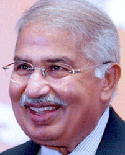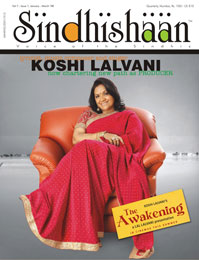BOMBAY PRESIDENCY, SINDH & SINDHIS – BUSINESS IMPLICATION
By Dr. Ram Buxani

 The other day, I happened to read a news item in Khaleej Times, a prominent Dubai-based daily. The report was very prominently displayed. It was about Mauritius Prime Minster Mr. Navinchandra Ramgoolam's visit to Bihar. It indeed sounded curious that the Prime Minster of Mauritius was visiting Bihar. Reading into the item I found that he had gone to Bihar in search of his roots. Like Ramgoolam many Mauritians had migrated from Bihar to Mauritius. Ramgoolam's grandfather Mohit was among the hundreds of labourers from villages across Bihar who were forcibly taken by the British to work in the sugarcane plantations of Mauritius in 1871. Nitish Kumar, Chief Minister of Bihar, who visited Mauritius last year, said he understood the pain of Mauritians of Bihari origin who were keen to trace their lineage.
The other day, I happened to read a news item in Khaleej Times, a prominent Dubai-based daily. The report was very prominently displayed. It was about Mauritius Prime Minster Mr. Navinchandra Ramgoolam's visit to Bihar. It indeed sounded curious that the Prime Minster of Mauritius was visiting Bihar. Reading into the item I found that he had gone to Bihar in search of his roots. Like Ramgoolam many Mauritians had migrated from Bihar to Mauritius. Ramgoolam's grandfather Mohit was among the hundreds of labourers from villages across Bihar who were forcibly taken by the British to work in the sugarcane plantations of Mauritius in 1871. Nitish Kumar, Chief Minister of Bihar, who visited Mauritius last year, said he understood the pain of Mauritians of Bihari origin who were keen to trace their lineage.
I started reflecting. One day Sindhis will also have to start tracing their roots. Bihari Mauritians are quite happy in their adopted land. Still they continue to crave for their roots and motherland. And that craving can never end.
Now let me come to the topic of this paper. The British set up the Presidency of Bombay in the 17th century as a trading post of the East India Company. It was surrounded by the Kingdom of Mysore and Madras Presidency in the south, Hyderabad and Central Provinces in the east, Rajputana, Punjab and Baluchistan to the north and the Arabian Sea in the west. The total area of approximately 188,750 square miles comprised of 122,990 square miles of British dominion and 65,760 square miles of Indian princely states. The area covered present day Gujarat, western Maharashtra, northwestern provinces of Karnataka, Sindh of Pakistan, and Aden in Yemen.
According to the 1901 census, population of Bombay Presidency was approximately 25.5 million, out of which, 20 million were Hindus, about 4.5 million were Muslims, and the remaining were Christians, Jains and Zoroastrians. Languages spoken in this Presidency were Marathi, Gujarati, Sindhi and Kannada. The first British settlement in the Bombay Presidency was in 1618. In the same year, East India company established a factory in Surat, till it was made a regular province through an act passed in 1935. Bombay Presidency played a significant role in the history of India and history of Sindhis.
Agriculture was the main occupation of the people in Bombay Presidency. Cotton, Oil seeds, Wheat, Millet, Sugarcane, Chillies, Tobacco and Turmeric were the main crops of this region. Cotton Milling and Weaving were major industries. Sindh played a crucial role in the handloom industry because of its traditions. Foreigners used to call Sindh, Suvasa the land of silk.
The economic prosperity of the people helped the growth of urban centers in the Presidency, where Sindhi business community exercised powerful influence. Sindhis pivotal role in the successful functioning of the economy was widely recognized, even by critics who resented the shift of power in favour of Sindhis in multicultural Sindh.
This wide geographical canvas was there for Sindhis to paint their future. And they did it with great mastery. Being part of the Bombay province greatly helped Sindh to expand its economic power.
Agriculture got a lift because of improved irrigation. Marketing of agriculture produce became more competitive because of improved communications. Wheat was generally grown in the northern part of the Presidency, especially in Sindh and Gujarat. It was exported to Europe in large quantities from Karachi, and on a smaller scale from Bombay.
Meantime, Karachi in Sindh evolved into a major commercial centre in the Presidency. The British built a modern port in Karachi with the labour from Bombay. Probably that accounts for the fact that the dock areas of the two cities of Bombay and Karachi look similar. It is also probable that many of the people who went to build the Karachi port stayed back. This would explain the commonality of attitudes and sensibilities, cultural expressions, rituals and practices among residents of Bombay and Karachi. In fact, it is not mere coincidence that both developed into commercial capitals of their respective countries after partition.
With the development of the port, traders and other merchants were drawn to Karachi from the coastal districts of the Bombay Presidency because of the possibilities it offered. The extent of migration from the coastline of western India was so great that Gujarati had become the lingua franca of the city by the inter-war period. The resultant prosperity only contributed to the growing power of Sindhi community's clout and influence.
By the time of partition in 1947, more than 25 per cent of the population of Sindh constituted Hindu Sindhis. Most of them were city dwellers. They were largely occupied with trade and commerce. They were responsible for the export of products made in Sindh. When partition became inevitable, the Sindhi Hindus expected to remain in Sindh. The relation between Hindu Sindhis and Muslim Sindhis was generally good and healthy then. But things began to change when large waves of Mohajirs started to pour into Sindh.
The loss of Bombay Presidency was a great down fall as far as the Sindhis were concerned. Had our community leaders resisted the demand in the 1930s to drop Sindh from the Presidency, we still would have been left with our homeland. Even during the partition there was no sustained campaign to carve out a Sindhi majority area for Sindhis, either by our own leaders or the leaders of the freedom struggle. The price is being paid by generations of Sindhis for such follies.
“Reason and Judgement are quality of a leader and this unfortunately was missing in many of the leaders of those times”
The world says we are a successful community. I think it forms the opinion not on the basis of our accomplishment. There is a saying: “Success is not measured by what you accomplish, but by the opposition you have encountered, and the courage with which you have maintained the struggle against overwhelming odds”. In this context yes, we are successful. Our forefathers have encountered and survived overwhelming odds.
There is a saying:
“Success is not built on success, it is built on failure, it is built on frustration, sometimes it is built on catastrophe”
Having lost during the partition their own wide and challenging playing field to conduct their business, the Sindhis had to start from scratch in their adopted lands. In India, Sindhis were settled in 96 refugee colonies where the living conditions were pathetic. They had to leave vocations like agriculture, farming and had to seek menial jobs or pursue small trades. Children were forced to forgo their studies and work to supplement family earnings. The harrowing experience of merely existing in such adverse conditions played havoc with the lives of countless Sindhis. An enterprising community was almost on the verge of being wasted. But our resilience came to our rescue.
The great American black leader Martin Luther King Jr. once said..
“If a man is called to be a street sweeper, he should sweep streets even as Michelangelo painted, or Beethoven composed music, or Shakespeare wrote poetry. He should sweep streets so well that all the hosts of heaven and earth will pause to say, here lived a great street sweeper who did his job well”
Yes, whatever vocations the Sindhis pursued in their adopted land they did them so well. A Sindhi generally looks at doors not walls. Perhaps, that is the reason for our smooth existence in our motherland. We could very well integrate with our host societies. Many of us even followed their customs, learned to speak their languages. No body will blame us being insular. But that is not the question. The question we should ask ourselves is whether we have the required will to preserve our identity.
I have a reason to feel that Sindhis did not play a strong role in greater Bombay Presidency in the overall context of the existence of Sindh and Sindhis. They, perhaps, considered detachment as independence and becoming stateless a greater independence!! Otherwise they would not have left their own land to become refugees. They could have put pressure on their leadership to negotiate and retain even a small portion of Sindh for Hindu Sindhis in order to avoid the migration. Tharparker was one such place. I am sure, Gandhi and Nehru and for that reason Jinha would not have objected to let Hindu Sindhis have a piece of land of their own instead of becoming so called “burden” on the ethnic population throughout the country. It is not only Sindhis who suffered but the whole country had to bear the burden.
Yes, it is true the Sindhis, being a proud and resourceful people, did not succumb. They never descended into despair and apathy amid the ruins of their shattered lives. They rose to the occasion, demonstrating a rare resilience seldom seen in the annals of human history. They re-established themselves, reinvented themselves; recreated themselves like a phoenix from the ashes. With great determination they established themselves as traders, businessmen and self-made entrepreneurs and prosperous industrialists who paid back their debts to the host community by setting up hospitals like Jaslok, Hinduja, Raheja and Hiranandani, besides number of charitable institutions, religious trusts and schools and colleges, especially in Bombay and around the country. They have excelled in enterprise and charities. But one sad fact remains: Hardly anything was done towards maintaining the community identity. The implications are :
• We have many schools run by Sindhis. Are they teaching Sindhi language?
No.
• We have many Sindhi builders. Quite prominent. Have they tried to build real estate with Sindhi architecture?
No.
• We have many well known Sindhi designers. Have they tried to re-introduce Sindhi dresses?
No.
• We have Sindhi hoteliers. Many of them are quite prominent. Have they tried to introduce Sindhi cuisine in their Menus?
No.
• We have Sindhi film makers. Have they tried to keep Sindhi culture and its folk tradition through the vast media they control? The reply is again
No. No. No.
Because all of them have been moving with the wind. They feel insecure to go against the market trend. They cater to the demand. But they do not create the demand. They do not feel responsible at all to preserve their own language, or their own culture, cuisine, heritage and architecture. This is the price the community is paying for the partition. I hope Sindhi Bhasha Bhavan in this campus will have Sindhi architecture in its elevation.
I know there is no easy answer to the many problems faced by the community. We can console ourselves with one thought. The Bombay Presidency had sharpened our skills of modern commerce. If we are still thriving in our commercial ventures around the world, we should express gratitude in our mind to the good old days of the Presidency where our forefathers learnt the tricks of international trade.
But as I said before, in spite of being successful in our ventures, the craving for our roots will always be with us. Future generations, like Mauritians, will want to know their origin. But it may be too late.
At present we do not have our heritage with us. Our heritage remains only in our memories. It will be cremated with us. In fact, it has already faded.
The next generation's memory won't be as vivid as ours. And the generation after that may remember even less. This will go on until the memories disappear completely from the collective conscience of the Sindhi psyche. This process has started. It depends on our collective will, if we have to reverse it.
I agree we cannot do much about the past. But past can be our greatest learning field. It is from our past that we learn not to repeat our mistakes. One lesson we should learn from our past is that we are living in our memories, and yet we have no place to keep the trophies of the memories of our glorious past! If we have no place, then what use in cherishing and longing for the past?
“Kismat Kai Judai Kahin Te Mayar Nahe” (Fate did not favour, can't blame anyone)
As I pointed out, had our leaders fought for a Sindhi Hindu majority area within the Presidency, the history of India and the history of Sindhis would have been different. We have survived. But Sindhis did not get the opportunity to utilize their capacity to the fullest. What we see today is hardly 10 per cent of Sindhi strength. Coffers of the country could have soared if Sindhis had an opportunity to rehabilitate in a land which they could call their own. What Dhirubhai Ambani could do in Gujarat, Sindhis would have done equally well or perhaps better in a piece of land of their own. Conveniently such place would have been the highest tax payer to the nation.
We need to live. We need a warehouse to store our culture, tradition, language and literature. We need to be explored by our nation. Our efforts get diluted because we are scattered. Collectively Sindhis want to flourish and contribute in a big way for the national economy. But the nation has not allowed one of the most potential communities to perform on its own playground and prove its skill and potential. The implication of not allowing the community to perform on its own platform is a great national loss. Considering the success of the community in India and elsewhere, it is safe to assume that such a place would have brought only glory to the country.
The master painter and sculptor Michelangelo once said..
“The greater danger for most of us is not that our aim is too high and we miss it, but that it is too low and we reach it”
When you determine what you want, you have made the most important decision in your life. You should know what you want in order to attain it. Abraham Lincoln was great, not because he once lived in a cabin, but because his goals got him out of it.
Some people would rather look backward than forward because it's easier to remember where you've been than to figure out where you're going. But we need to correct it. Now.
Margaret Mead has said :
“Never doubt that a small group of thoughtful, committed people can change the world. Indeed. It is the only thing that ever has”
Look for your passion and follow it, come what may, but do it from a Sindhi perspective, where you are guided by the effect of what you do on your family and your community. Being Sindhi is emotional, is spiritual, and to me it means moral structure; what is good, what is right, what is just. All this will become more important as we go through some tough times ahead. We need to build on that.


